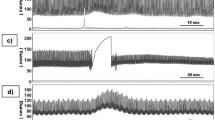Abstract
Cross-correlation between cerebral blood flow (CBF) and background EEG activity can indicate the integrity of CBF control under changing metabolic demand. The difficulty of obtaining long, continuous recordings of good quality for both EEG and CBF signals in a clinical setting is overcome, in the present work, by an algorithm that allows the cross-correlation function (CCF) to be estimated when the signals are interrupted by segments of missing data. Methods are also presented to test the statistical significance of the CCF obtained in this way and to estimate the power of this test, both based on Monte Carlo simulations. The techniques are applied to the time-series given by the mean CBF velocity (recorded by transcranial Doppler) and the mean power of the EEG signal, obtained in 1 s intervals from nine sleeping neonates. The peak of the CCF is found to be low (≤0.35), but reached statistical significance (p<0.05) in five of the nine subjects. The CCF further indicates a delay of 4–6s between changes in EEG and CBF velocity. The proposed signal-analysis methods prove effective and convenient and can be of wide use in dealing with the common problem of missing samples in biological signals.
Similar content being viewed by others
References
Aaslid, R. (1987): ‘Visually evoked dynamic blood flow response of the human cerebral circulation’,Stroke,18, pp. 771–775
Anonymous (1996): ‘Heart rate variability: standards of measurement, physiological interpretation, and clinical use’,Circulation,93, pp. 1043–1065
Blaber, A. P., Bondar, R. L., Stein, F., Dunphy, P. T., Moradshahi, P., Kassam, M. S., andFreeman, R. (1997): ‘Transfer function analysis of cerebral autoregulation dynamics in autonomic failure patients’,Stroke,28, pp. 1686–1692
Bland, M. (1995): ‘An introduction to medical statistics, 2nd edn.’ (Oxford University Press, Oxford)
Bode, H. (1992): ‘Intracranial blood flow velocities during seizures and generalized epileptic discharges’,Eur. J. Pediatr.,151, pp. 706–709
Boylan, G. B., Panerai, R. B., Rennie, J. M., Evans, D. H., Rabe-Hesketh, S., andBinnie, C. D. (1999): ‘Cerebral blood flow velocity during neonatal seizures’,Arch. Dis. Child.,80, pp. F105-F110
Brockwell, P. J., andDavis, R. A. (1987): ‘Time series: theory and methods’ (Springer-Verlag, New York)
De Simone, R., Silvestrini, M., Marciani, M. G., andCuratolo, P. (1998): ‘Changes in cerebral blood flow velocities during childhood absence seizures’,Pediatr. Neurol.,18, pp. 132–135
Ferrari, F., Kelsall, A. W. R., Rennie, J. M., andEvans, D. H. (1994): ‘The relationship between cerebral blood flow velocity fluctuations and sleep state in normal newborns’,Pediatr: Res.,33, pp. 50–54
Greisen, G., Hellstrom-Westas, L., Lou, H. C., Rosen, I., andSvenningsen, N. W. (1985): ‘Sleep-waking shifts in cerebral blood-flow in stable preterm infants’,Pediatr. Res.,19, pp. 1156–1159
Hajak, G., Klingelhöfer, J., Schulz-Varszegi, M., Matzander, G., Sander, D., Conrad, B., andRüther, E. (1994): ‘Relationship between cerebral blood flow velocities and cerebral electrical activity in sleep’,Sleep,17, pp. 11–19
Isaksson, A. J. (1993): ‘Identification of ARX-models subject to missing data’,IEEE Trans. Autom. Control,AC-38, pp. 813–819
Jorch, G., Huster, T., andRabe, H. (1990): ‘Dependency of Doppler parameters in the anterior cerebral artery on the behavioural states in term and preterm neonates’,Biol. Neonate,58, pp. 79–86
Kay, S. M. (1988): ‘Modern spectral estimation: theory and application’ (Prentice Hall, Englewood Cliffs, New Jersey)
Klingelhöfer, J., Bischoff, C., Sander, D., Wittich, I., andConrad, B. (1991): ‘Do brief bursts of spike and wave activity cause a cerebral hyper-or hypoperfusion in man?’,Neurosci. Lett.,127, pp. 77–81
Klingelhöfer, J., Hajak, G., Matzander, G., Schulz-Varszegi, M., Sander, D., Rüther, E., andConrad, B. (1995): ‘Dynamics of cerebral blood flow velocities during normal human sleep’,Clin. Neurol. Neurosurg.,97, pp. 142–148
Laird, N. M. (1988): ‘Missing data in logitudinal studies’,Stat. Med.,7, pp. 305–315
Manly, B. F. J. (1997): ‘Randomization, bootstrap and Monte Carlo methods in biology, 2nd edn.’ (Chapman & Hall, London)
Panerai, R. B., Rennie, J. M., Kelsall, A. W. R., andEvans, D. H. (1998): ‘Frequency-domain analysis of cerebral autoregulation from spontaneous fluctuations in arterial blood pressure’,Med. Biol. Eng. Comput.,36, pp. 315–322
Pyper, B. J., andPeterman, R. M. (1998): ‘Comparison of methods to account for autocorrelation in correlation analyses of fish data’,Can. J. Fish. Aquat. Sci.,55, pp. 2127–2140
Ruf, R. (1999): ‘The Lomb-Scargle periodogram in biological rhythm research: analysis of incomplete and unequally spaced time-series’,Biol. Rhythm Res.,30, pp. 178–201
Schreiber, T. (1998): ‘Constrained randomization of time series data’,Phys. Rev. Lett.,80, pp. 2105–2108
Theiler, J., Eubank, S., Longtin, A., Galdrikian, B., andFarmer, J. D. (1992): ‘Testing for nonlinearity in time series: the method of surrogate data’,Physica D,58, pp. 77–94
Theiler, J., andPrichard, D. (1996): ‘Constrained-realization Monte Carlo method for hypothesis testing’,Physica D,94, pp. 221–235
Author information
Authors and Affiliations
Corresponding author
Rights and permissions
About this article
Cite this article
Simpson, D.M., Infantosi, A.F.C. & Botero Rosas, D.A. Estimation and significance testing of cross-correlation between cerebral blood flow velocity and background electro-encephalograph activity in signals with missing samples. Med. Biol. Eng. Comput. 39, 428–433 (2001). https://doi.org/10.1007/BF02345364
Received:
Accepted:
Issue Date:
DOI: https://doi.org/10.1007/BF02345364




